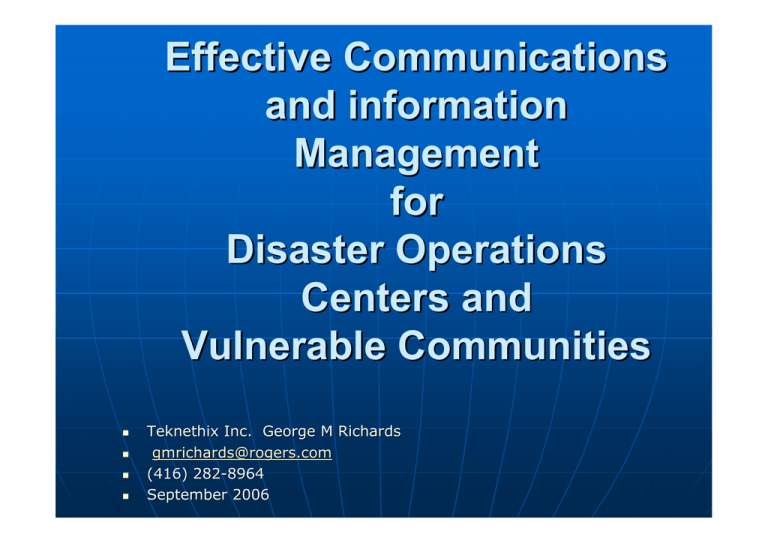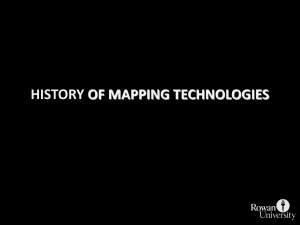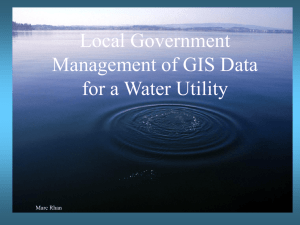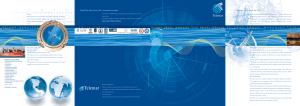Effective Communications and information Management for
advertisement

Effective Communications and information Management for Disaster Operations Centers and Vulnerable Communities Teknethix Inc. George M Richards gmrichards@rogers.com (416) 282-8964 September 2006 Hyogo Framework for Action (HFA) Goal #2… development and strengthening of institutions, mechanisms and capacities at all levels, especially community level, to build resilience to hazards. HFA (Continued) Priority 2.4… Establish a hazard monitoring program including effective, timely and reliable peoplecentred early warning and alert systems at the national and local levels. Operational Entities Committee Chairperson Shelter Manager Operations Manager Community Site Media Community Site Operations Center Community Site Government Security / Rescue Works / Utilities Current Technologies Used WIDESPREAD International/Regional Agency Websites TV,Radio & Weather Bulletins Live “Call-In” radio programs LIMITED AVAILABILITY E-Newsletters & Event Websites* Cell, SMS, HAM Radio, SatPhone* Much More is Required.. Pena has three items he would like to see put in place for local first responders: The ability to communicate with each other at the (field) command level Communication with the local office of emergency management set up as the central point of resource requests, so that OEM can coordinate, prioritize and avoid duplication of efforts Communications starting with basic radio for local communications, along with cell phones, direct-connect phones and BlackBerry devices. Pena said backup or redundant systems such as self-powered radios, hard-wired communications, mobile communication systems and auxiliary power backups should be in place if needed. (Senior FEMA Planner – formerly New York City Senior Responder Much More…. In accepting the donation, Deputy Director of NODS Philmore Mullin said: “Even though our systems have improved since Hugo, there is always a need for an enhanced system of communication as technology improves. We are very grateful for such a timely gift which will greatly enhance the ability of district disaster chairpersons to communicate with NODS in times of emergency. It will also significantly improve our communications with Barbuda.” Deputy Director of NODS (Antigua & Barbuda) The Requirements are.. Managed & Consistent 2-Way Information exchange Timely, Relevant, Accurate Information Rugged, Affordable, Easy-to-Use ICT Standards-based hardware, software & communications Desired ICT Environment EMERGENCY CENTER COMMUNITY Hand Held Device Database & Analysis Pen computer IBM Compatible COLLECTION & ANALYSIS ACQUISITION Website Information Distribution Internet REPORTING Simply Put.. 1. ACQUIRE Information from Communities 2. ANALYZE 3. DISSEMINATE and Integrate information at the Operations Center information in a variety of formats 1. Situational Data Acquisition Data Sources Remote Sensing – Satellite Imagery, Weather Radar, Ocean Buoys Geo-Spatial Representations- GIS, GPS, Information Mapping Field Observation /Data AcquisitionHand Held PDAs, Converged Voice, Dara, video Community / Field Location BROADBAND INTERNET DIGITAL DATA VOICE VIDEO Satellite dish Pen computer 3G Wireless Lamndline Laser printer Fax Handheld Programming Windows PC Software Easy-to-Program Creates database Multiple data formats Stylus, touch screen GPS-enabled Uploading to central database Satellite Terminals Size – 10” x 10” Weighht - < 1.5 Kg Quick PC setup Low Power Indoor & Outdoor Mobile, Marine Use ~ 450 kbps TCP/IP & Voice Examples of Technology MS Visual Studio PDAs & Handheld PCs – HP, Toshiba, Dell Portable Satellite Terminals – Hughes, Thrane & Thrane, Nera Satellite Service – INMARSAT (BGAN) (Region-wide Footprint) 2. Information Integration Key Needs Centralized Databases – Multimedia digital, graphic, voice Information Management – Realtime, Historical, Forecast, Simulation Information Analysis – Multi-use, planning, operational, research. ICT Capabilities at the Operations Center Real-time database updating Recording of geo-spatial, digital, voice & video formats Integrating current and historical Automated Analysis - by Location, significance, chronological & by incident category Information Integration BROADBAND INTERNET SATELLITE IMAGERY DATA SENSORS EVENT FORECASTS SERVERS DATABASE Tower box SITUATION ANALYSIS PRINTER WEBSITE GIS STATISTICAL Software DISASTER MODELS SIMULATIONS GIS Structure TOPOLOGY FEATURES DEMOGRAPHICS INFRASTRUCTURE Data VEGETATION HAZARDOUS AREAS STOREM SURGE WIND DAMAGE FLOODING MUD / LANDSLIDES Examples of Technology ESRI ArcGIS SAS / GIS Statistical Software LAMP (Linux, Apache, MySQL, PHP) RealNetworks Helix Streaming Suite Information Reporting Key Needs Internet distribution User-specified On-demand Reporting Map-based real-time situations Automated priority alerts (E-Mail, RSS, Text messaging) Archival access (summary & detail) Reporting Prioritized Situation Reports Map-based Risk Representations On-Demand Statistical Analyses / Trends Detailed Fieldf Observations L(Damage Assessments) Projections/ Simulations Asset / Inventory Reports General Public Community Site Research Community Government Operations Center Works / Utilities INTERNET Media Security / Rescue Examples of Technology Crystal Report Generator ArcExplorer (ESRI) RSS Server Constant Contact – E-Newsletters Open ACS -Website Content Manager TECHNOLOGY SUMMARY Low-Cost, Industry-Standard, Adaptable Suitable for small pilot tests and for full-scale multi-sector/ multiapplication programs Easy to Operationalize / Easy to use (CyberTracker) Thank You Partial List of Web Sites http://msdn.microsoft.com/vstudio/ http://www.hp.com/country/us/en/pr odserv/handheld.html http://broadband.inmarsat.com/abou t/explorer_700.aspx?language=EN&te xtonly=False http://broadband.inmarsat.com/defau lt.aspx?language=EN&textonly=False Web Sites (Continued) http://www.esri.com/ http://www.realnetworks.com/index. html http://www.sas.com/products/gis/ http://www.crystalreports.co.uk/ http://search.constantcontact.com/in dex.jsp







